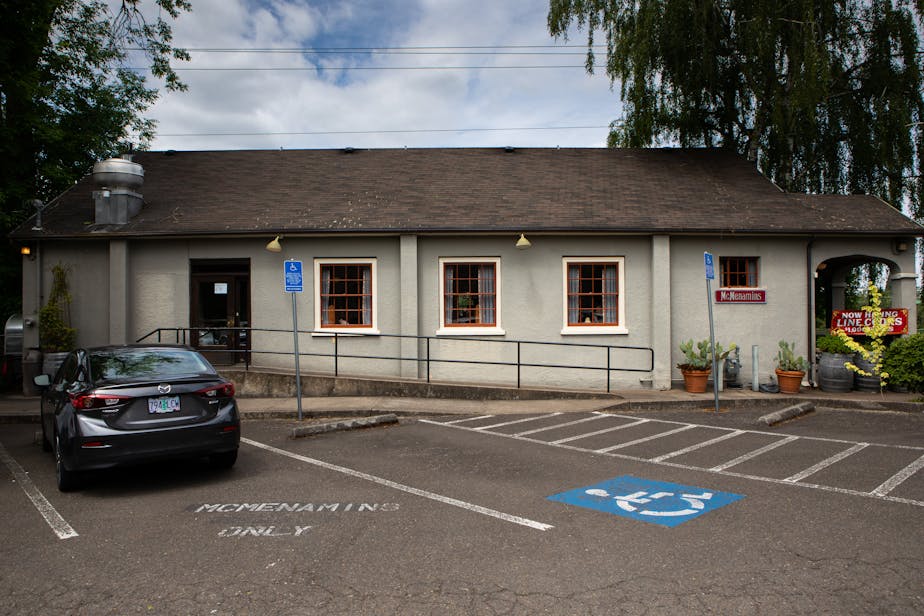Last weekend I met friends for lunch in Oregon City and took the opportunity to go on a little historic photo walk while I was in town. Despite growing up in the Portland area, I've never explored this historic town, which was the first incorporated city west of the Rocky Mountains (in 1844) and the primary destination at the end of the Oregon Trail.

As so often happens, it's thanks to out-of-town visitors that I've even been to Oregon City at all. About 10 years ago, a friend from Scotland asked to see the End of the Oregon Trail Museum, and about 5 years ago, a visitor from England wanted to see Willamette Falls based on a brochure. But I never managed to make it back for proper exploring, until now.

Lunch was on the patio at {place1727736}, which is located in a former Episcopal church dating from 1930. The gray building is not particularly exciting in itself but, as always, McMenamins has done a great job of covering the interior with art and plants that bring it to life. The patio was spacious and pleasant as well. It's conveniently located in the heart of historic downtown, just across McLoughlin Blvd from the Willamette River. If you've never been to a McMenamins before, the tater tots are a must.
After lunch, we wandered the adjacent Main Street, a quaint and historic thoroughfare with an interesting array of restaurants and shops. We stopped in at Sweet Masterpiece, an artisanal chocolate shop and bakery specializing in natural ingredients. I found room for a lemon tart, which was exceptionally delicious, and a very tasty disk of dark chocolate with dried berries on top. The baker who served up these treats was excited to talk about their products, natural ingredients, and enthusiasm for catering to just about any dietary preference.
A block over from Main Street is the {place1091292}, a historic site and local landmark. Completed in 1955, it has a wonderful Space-Age appearance very much of its era. Free and fast, the elevator is the best way to get to Oregon City's upper neighborhood, which is home to its most important historic sites. The flying-saucer-like observatory deck at the top provides great views of the lower town and houses a tourist information desk.


The outdoor staircase near the elevator, also historic, is in an attractive wooded setting next to a man-made waterfall. We descended a couple of flights to use the tunnel under a street, which emerges right next to the McLoughlin House and Barclay House. Both historic houses date from the 1850s and were moved from the riverfront to save them from demolition. They now sit together in a small park and, along with McLoughlin's grave, are part of the Fort Vancouver National Historic Site. Both contain museums, which are currently closed due to the pandemic.


There are several other historic houses in the area, each attractively labeled with their name, date and architectural style. After admiring some of these, and stopping to visit with a friendly black cat, we headed south a few blocks to another convenient cluster of historic buildings: a firehouse, a Carnegie library, several more historic houses, and a quirky old church.

The {place250729} (originally First Congregational) is a charmingly odd, pale-pink interpretation of the Gothic Revival style dating from 1925. It isn't currently open, due to the pandemic, but it is known for its stained glass windows so would be worth a look inside.
Back at the Municipal Elevator, we turned left onto the McLoughlin Promenade. Listed on the National Register of Historic Places, this 7-mile path on the edge of the bluff was one of the highlights of our visit. Following the gently sloping paved path lined with colorful wildflowers, we walked less than a mile and enjoyed spectacular views of the lower town, the Willamette River, Willamette Falls, and picturesquely decaying mill buildings. We daydreamed about what McMenamins could do with all that historic property on the river... the soaking pools, hidden rooms, and rooftop bars! The area is apparently under development, but I'm not sure what the plans for it are.

There are more historic attractions to see in Oregon City (most notably the End of the Oregon Trail Museum) but as you can see, the exteriors of the main attractions can all be visited on foot in an hour or two. I look forward to returning when the buildings are open again, but highly recommend a visit anytime.
